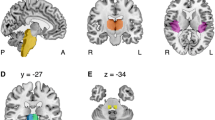Abstract.
There is considerable evidence from studies on cats and monkeys that several cortical areas such as area 2v at the tip of the intraparietal sulcus, area 3av in the sulcus centralis, the parietoinsular vestibular cortex adjacent to the posterior insula (PIVC) and area 7 in the inferior parietal lobule are involved in the processing of vestibular information. Microelectrode recordings from these areas have shown that: (1) most of these cortical neurons are connected trisynaptically to the labyrinthine endorgans and (2) they receive converging vestibular, visual and somatosensory inputs. These data suggest that a multimodal cortical system is involved in postural and gaze control. In humans, recent positron emission tomography (PET) scans and functional magnetic resonance imaging (fMRI) studies have largely confirmed these data. However, because of the limited temporal resolution of these two methods, the minimum time of arrival of labyrinthine inputs from the vestibular hair cells to these cortical areas has not yet been determined. In this study, we used the evoked potential method to attempt to answer this question. Due to its excellent temporal resolution, this method is ideal for the investigation of the tri- or polysynaptic nature of the vestibulocortical pathways. Eleven volunteer patients, who underwent a vestibular neurectomy due to intractable Meniere's disease (MD) or acoustic neurinoma resection, were included in this experiment. Patients were anesthetized and the vestibular nerve was electrically stimulated. The evoked potentials were recorded by 30 subcutaneous active electrodes located on the scalp. The brain electrical source imaging (BESA) program (version 2.0, 1995) was used to calculate dipole sources. The latency period for the activation of five distinct cortical zones, including the prefrontal and/or the frontal lobe, the ipsilateral temporoparietal cortex, the anterior portion of the supplementary motor area (SMA) and the contralateral parietal cortex, was 6 ms. The short latency period recorded for each of these areas indicates that several trisynaptic pathways, passing through the vestibular nuclei and the thalamic neurons, link the primary vestibular afferents to the cortex. We suggest that all these areas, including the prefrontal area, process egomotion information and may be involved in planning motor synergies to counteract loss of equilibrium.
Similar content being viewed by others
Author information
Authors and Affiliations
Additional information
Electronic Publication
Rights and permissions
About this article
Cite this article
de Waele, .C., Baudonnière, .P., Lepecq, .J. et al. Vestibular projections in the human cortex. Exp Brain Res 141, 541–551 (2001). https://doi.org/10.1007/s00221-001-0894-7
Received:
Accepted:
Issue Date:
DOI: https://doi.org/10.1007/s00221-001-0894-7




